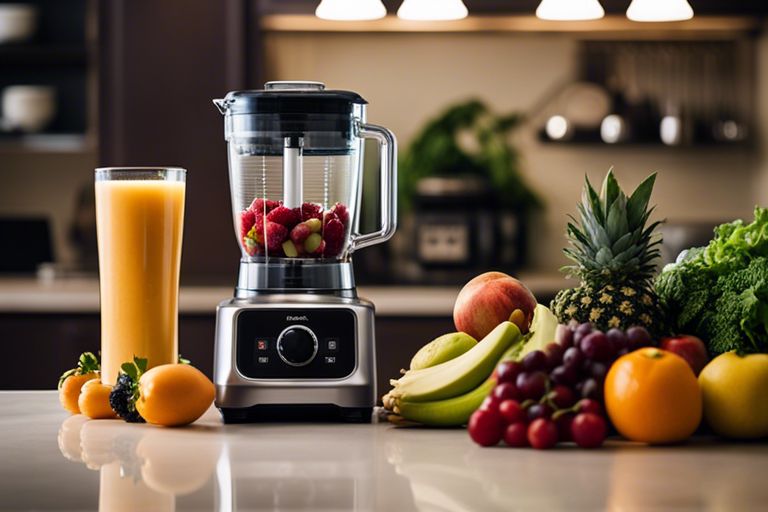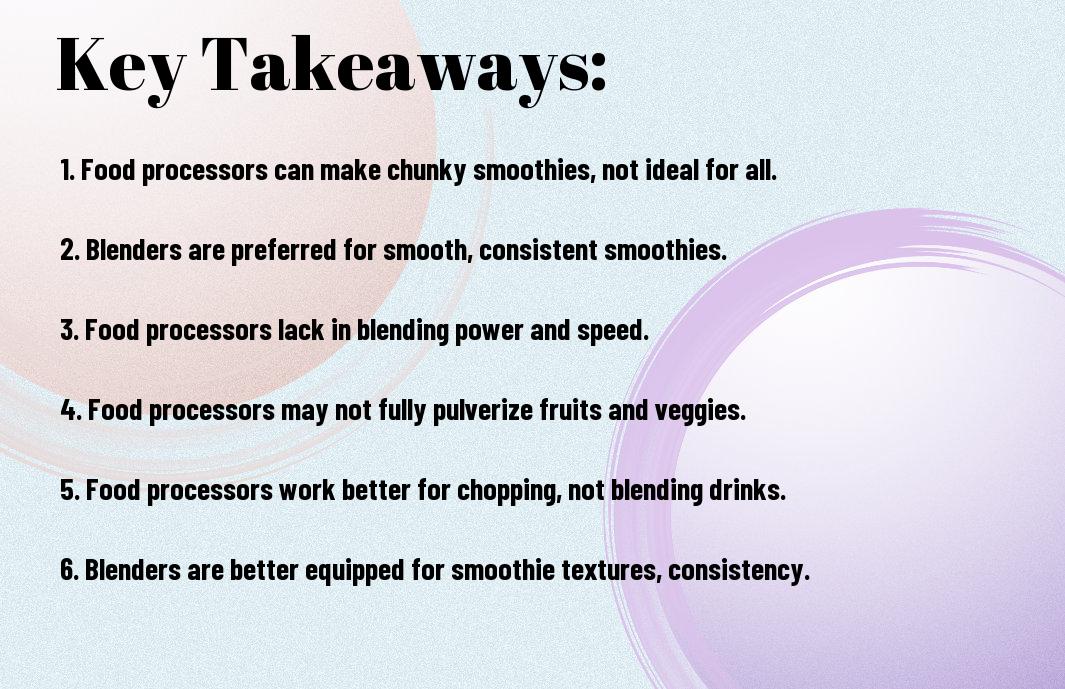You may be wondering if your trusty food processor can pull double duty and whip up a delicious smoothie for you. While a food processor is not the ideal tool for making a smoothie, it can definitely get the job done in a pinch. In this article, we’ll explore the ins and outs of using a food processor to make a smoothie, along with some tips to ensure your smoothie turns out perfectly blended and delicious.

Key Takeaways:
- Yes, but with limitations: While a food processor can be used to make a smoothie, it may not produce the same consistency as a blender due to its different blade design.
- Consider the ingredients: Food processors are better suited for chopping and blending solid ingredients, so using softer fruits and adding liquid may help achieve a smoother texture.
- Experiment and adjust: If using a food processor for smoothies, be prepared to experiment with different ingredients, ratios, and processing times to find the right combination for a satisfying smoothie.

The Basics of Food Processors
What is a Food Processor?
Before we research into using a food processor to make a smoothie, let’s start with the basics. A food processor is a versatile kitchen appliance designed to aid in food preparation. It is equipped with interchangeable blades and disks that allow you to chop, slice, shred, grind, puree, and mix ingredients with precision and speed.
Common Features of Food Processors
One of the common features of food processors is the large capacity bowl, which enables you to process a significant quantity of ingredients at once. Additionally, most food processors come with various speed settings and pulse options to give you more control over the texture of your food.
This kitchen appliance typically includes attachments such as a chopping blade, a dough blade, slicing and shredding discs, and a mixing blade. These attachments, combined with the power of the motor, make a food processor a valuable tool for a wide range of cooking tasks.
The Basics of Smoothies
Clearly, before we investigate whether you can use a food processor to make a smoothie, let’s first understand the basics of what a smoothie actually is.
What is a Smoothie?
For those unacquainted with the marvel that is a smoothie, allow me to enlighten you. A smoothie is a blended beverage typically made with a combination of fruits, vegetables, liquid (such as water, juice, or milk), and ice. The result is a thick, creamy concoction that is not only delicious but also incredibly nutritious.
Typical Ingredients in Smoothies
Smoothies are like a blank canvas waiting for you to unleash your creativity in the kitchen. While the possibilities are endless, some typical ingredients you’ll find in a smoothie include fruits like bananas, berries, and mangoes, leafy greens such as spinach or kale, protein sources like yogurt or protein powder, and additional boosts like chia seeds or nut butter.
This versatile blend of ingredients ensures that your smoothie not only tastes amazing but also packs a powerful nutritional punch. It’s a convenient way to sneak in necessary vitamins, minerals, and fiber into your diet, all in one delicious gulp.
Can You Use a Food Processor to Make a Smoothie?
The Short Answer
To put it simply, yes, you can use a food processor to make a smoothie. However, there are some limitations to consider when using a food processor for this purpose.
The Long Answer: Why It’s Not Ideal
Smoothies are all about achieving a perfectly smooth and creamy texture that is easy to sip and enjoy. While a food processor can certainly blend ingredients together, it may not be able to achieve the same level of smoothness that a dedicated blender can provide. Food processors are designed for chopping, mixing, and pureeing ingredients to a certain extent, but they lack the high-speed blending power that blenders have to completely liquefy ingredients like frozen fruits, leafy greens, and nuts.
It’s important to note that using a food processor for smoothies may result in a more chunky or uneven texture, which can be less than ideal if you prefer a silky smooth consistency in your drink. Additionally, the blades of a food processor are not typically designed to create the vortex action needed to fully incorporate all ingredients evenly, leading to a less homogenous mixture.
Why Food Processors Aren’t Designed for Smoothies
Now, food processors are versatile kitchen appliances that excel at tasks like chopping, slicing, and shredding. However, when it comes to making smoothies, they may not be the best choice. Let’s explore a couple of reasons why food processors aren’t ideal for blending up your favorite fruity drinks.
Blade Design and Speed
One reason why food processors may not be the best tool for making smoothies is their blade design and speed. Food processors typically come with sharp, multi-functional blades that are more suited for chopping and mixing rather than pureeing ingredients into a smooth consistency. Additionally, food processors are designed to operate at lower speeds compared to blenders, which can result in a less smooth and consistent texture when blending ingredients.
Capacity and Liquid Handling
With food processors, their narrow and tall work bowls are great for holding dry ingredients for chopping or mixing, but they may not be as ideal for blending liquids like smoothie ingredients. The limited capacity and liquid handling capability of food processors can lead to ingredients not being blended evenly, resulting in a chunky or inconsistent smoothie texture.
Understanding the limitations of food processors when it comes to making smoothies can help you make an informed decision about which kitchen appliance to use for your blending needs. While food processors can be great for certain tasks, investing in a quality blender designed specifically for making smoothies can help you achieve the perfect creamy and smooth consistency you desire.
Alternatives to Food Processors for Smoothies
Blenders: The Better Option
One alternative to using a food processor for making smoothies is to use a blender. Blenders are specially designed for blending fruits and vegetables into smooth and creamy concoctions. They are equipped with sharp blades that can easily pulverize ingredients, ensuring a smoother texture compared to a food processor.
Blenders also come in a variety of sizes and styles, making it easy to find one that suits your needs and kitchen space. Whether you prefer a countertop blender for large batches or a personal blender for single servings, blenders are a more efficient and effective option for creating delicious smoothies.
Immersion Blenders: A Good Alternative
Alternative to using a food processor or a regular blender, immersion blenders offer a convenient and more accessible option for making smoothies. These handheld stick blenders can be immersed directly into a glass or pitcher, allowing you to blend your ingredients without the need for transferring them to a separate container.
For instance, if you’re looking to make a quick single-serving smoothie, an immersion blender can easily blend your fruits, vegetables, and liquids in seconds. They are also easy to clean and store, making them a practical choice for those with limited kitchen space.
Hacks for Using a Food Processor for Smoothies
Despite being primarily designed for chopping and slicing, a food processor can also be a handy tool for making delicious and nutritious smoothies. Here are some hacks to help you get the most out of your food processor when whipping up a smoothie.
Adding Liquid in Small Amounts
For optimal smoothie-making in a food processor, it’s crucial to add liquid in small amounts. Start by adding just a splash of liquid to the food processor bowl along with your fruits, vegetables, and other ingredients. This will help the blades to process the mixture more efficiently without getting stuck. You can always add more liquid gradually as needed to achieve your desired consistency.
Using the Pulse Function
Adding the liquid first and using the pulse function intermittently can help create a smoother blend in a food processor. Pulse the ingredients in short bursts rather than running the processor continuously. This way, you can control the consistency of your smoothie better and avoid over-processing, which can result in a watery or uneven texture.
Adding ingredients like frozen fruits or ice cubes in small batches and pulsing them a few times before adding more can also help ensure a well-blended and creamy smoothie.
Understanding
Avoiding Over-Processing
Using a food processor for smoothies requires a bit of finesse to avoid over-processing. Over-processing can break down the ingredients too much, leading to a thin and watery smoothie instead of a thick and creamy one. To prevent this, pulse the ingredients and stop periodically to scrape down the sides of the bowl to ensure even blending.
Using the Pulse Function
To avoid over-processing, it’s crucial to use the pulse function strategically. Be mindful of how long and how often you pulse the ingredients to achieve the desired texture. Recall, it’s better to under-process slightly and have a few small chunks in your smoothie than to over-process and end up with a runny consistency. Pulse in short intervals until you reach your preferred smoothie consistency.
Summing up
With these considerations in mind, it is clear that using a food processor to make a smoothie is not the most ideal option. While it is possible to use a food processor for this purpose, the results may not be as smooth and consistent as those achieved with a blender. Additionally, the risk of over-processing the ingredients and ending up with a gloopy mess is higher when using a food processor for smoothies.
Ultimately, investing in a high-quality blender specifically designed for making smoothies is the best way to ensure a perfectly blended and delicious drink every time. While a food processor can be a versatile kitchen tool, it is best suited for tasks other than making smoothies.
FAQ
Q: Can I use a food processor to make a smoothie?
A: While a food processor can technically be used to make a smoothie, it may not give you the ideal texture you are looking for. A blender is typically better suited for making smoothies as it can break down fruits and vegetables more efficiently into a smoother consistency.
Q: What are the advantages of using a food processor for making smoothies?
A: Using a food processor for making smoothies can be advantageous if you prefer a chunkier texture or if you want to incorporate ingredients that are better processed with a food processor, such as nuts or seeds.
Q: How can I make a smoothie in a food processor?
A: To make a smoothie in a food processor, start by adding your fruits, vegetables, liquid (like juice or milk), and any additional ingredients into the bowl of the food processor. Pulse the food processor until the ingredients are blended to your desired consistency.
Q: What are some tips for making a smoothie in a food processor?
A: To ensure a smoother consistency when using a food processor for making smoothies, consider cutting your fruits and vegetables into smaller pieces before adding them to the processor. You can also add more liquid to help the ingredients blend more easily.
Q: Can I use a food processor for specific types of smoothies?
A: Yes, a food processor can be great for making certain types of smoothies, such as nut butter smoothies or smoothies with chunky mix-ins. Experiment with different ingredients and techniques to find the best use of your food processor for making delicious and creative smoothies.
